- 1River Basin Hub Operation Management Center, China Three Gorges Corporation, Yichang, China
- 2Hubei Key Laboratory of Operation Safety of High Dam and Large Reservoir (China Three Gorges Corporation), Yichang, Hubei, China
- 3Three Gorges Geotechnical Consultants Co., Ltd, Wuhan, Hubei, China
- 4College of Geophysics, Chengdu University of Technology, Chengdu, Sichuan, China
Abundant and well-documented seismic data have shown that there is a significant correlation between the earthquakes and water impoundment in the Three Gorges Reservoir Region and hydraulic fracturing operations on Well EYY1 and Well EYY2 within this area were conducted to stimulate the shale gas. Monitoring detected numerous induced microseismic events during these industrial activities. However, discriminative analysis between reservoir-induced seismicity and hydraulic fracturing induced seismicity remains conspicuously absent. This paper provides a case study in the Three Gorges Reservoir Region where water impoundment and hydraulic fracturing operation were simultaneously conducted in a certain time. Findings show that most of the micro and small earthquakes were induced by the impoundment of the Three Gorges Reservoir, and were mainly distributed along the Yangtze River and its branches during the year of 2016–2019. The emerging cluster of earthquakes in the Xiannvshan Fault area of the Three Gorges Reservoir Region was induced by hydraulic fracturing on Well EYY1 and Well EYY2, rather than by impoundment, and the relationship between seismicity observed and hydraulic fracturing activities belongs to the rapid-response type. The emerging cluster of earthquakes observed in the area are predominantly associated with rock fracturing processes controlled by pre-existing natural fractures and in-situ stress regimes, with no evidence suggesting fault reactivation induced by hydraulic fracturing operations.
1 Introduction
In recent years, human-induced earthquakes which can be caused by impoundment of reservoirs, underground mining, geothermal operations, oil and gas production, and water injection have been a scientific hotpot (Davies et al., 2013; Ellsworth, 2013; Lei et al., 2017; Sun et al., 2017; Zhang et al., 2021; Zou et al., 2024). Reservoir-induced seismicity (RIS) refers to earthquakes induced by the impoundment of water reservoir. Cases of RIS can be observed at the Koyna-Warna Reservoir in India (Gupta, 2002), the Nurek Reservoir in Tajikistan (Soboleva and Mamadaliev, 1976; Leith et al., 1981), the Aswan region in Egypt (Stabile et al., 2024) and the Three Gorges Reservoir in China (Yao et al., 2017; Zhang et al., 2018; Zhang et al., 2019; Zhang et al., 2024). The first documented case of RIS was reported within Lake Mead, United States, demonstrating a correlation between seismic activity and both the water level fluctuations and the corresponding changes in water load during the period from 1935 to 1944 (Carder, 1945), and four catastrophic events with magnitudes exceeding six have been recognized as RIS (Gupta et al., 1972; Gupta, 2002; Zhang et al., 2019; Zhang et al., 2024). Case studies of seismicity induced or triggered by gas production are known from different regions and links between seismicity and hydraulic fracturing or wastewater disposal have been widely examined (Dahm et al., 2007; Suckale, 2010; Ellsworth, 2013; Lei et al., 2017; Hu et al., 2021; Li et al., 2021; Xu et al., 2021). Shale itself serves as an ultra-compact reservoir characterized by extremely low porosity and permeability, making it essential to create new fracture networks or activate natural fractures for commercial shale gas extraction. The properties of shale such as brittleness, wettability, physical and mechanical parameters, evolution mechanism of fracturing fracture system have been researched for a better understanding the mechanisms of shale gas storage and production (Liu et al., 2024; Ren et al., 2024; Wang et al., 2024). Hydraulic fracturing played a pivotal role in enhancing the shale gas production and exploitation (Zhao et al., 2022; Hui et al., 2023; Ren et al., 2024) and numerous cases exist where seismicity has been triggered by hydraulic fracturing during shale gas extraction (Wang et al., 2016; Schultz et al., 2017; Wang et al., 2020; Zhao et al., 2020; Hui et al., 2021). The classic mechanisms of hydraulic fracturing induced seismicity (HFIS) include increased pore pressure, poroelastic stress perturbation, and aseismic fault slip or the reactivation of pre-existing faults (Ellsworth, 2013; Eyre et al., 2019). Zoback and Townend (2001) pointed that a series of seismic events induced by fault slip during hydraulic fracturing operations in the Barnett shale. Jun et al. (2018) addressed that the sudden increase of seismicity in Shangluo area, Sichuan Province, China, is likely to be related to the hydraulic fracturing operations during the exploitation of the local shale gas. Hydraulic fracturing has been shown to induce large seismic activity, imposing danger to the personnel and property, as evidenced by multiple documented cases (Zhao et al., 2021; Hui et al., 2023). Previous research has predominantly focused on RIF or HFIS as isolated phenomena. However, as the scenario where reservoir water impoundment and shale gas extraction occur simultaneously is relatively rare, there has been a critical absence of comparative studies investigating these dual inducing mechanisms within shared geological settings.
The Three Gorges Project in central China is one of largest-scale water conservancy projects in the world. The dam stands at an elevation of 185 m with a maximum impoundment level of 175 m and a crest length of 2,335 m. The Three Gorges Reservoir including Chongqing section and Hubei section (Figure 1) has a total storage capacity of 39.3 billion cubic meters. After its impoundment, the seismic activity in the reservoir area greatly increased (Yao et al., 2017; Zhang et al., 2018; Zhang et al., 2019). The abundant and well-documented seismic data have shown that there is a significant correlation between the earthquakes and water impoundment, making it to be an important site for studying RIS. Special Report on the Feasibility Study of the Yangtze River Key Water Control Project prepared by the Yangtze River Basin Planning Office (now reorganized as the Yangtze River Basin Planning Office) in May 1989 demonstrated that the segments where the Jiuwanxi Fault to Xiannvshan Fault and the Gaoqiao Fault extend possess significant seismic potential, with the capability of generating earthquakes exceeding magnitude 5.0 (Figure 1), while the seismic background of the reservoir area is weak. Three large earthquakes, namely, the Badong M5.1 earthquake on 16 December 2013 and the Zigui M4.3 and M4.1 earthquakes on June 16 and 18, 2017, occurred during the process of water storage. The Yichang slope, adjacent to Xiannvshan Fault area, is located on the southeastern edge of the Huangling paleo-uplift, and represents a promising new exploration target for shale gas resources within multiple stratigraphic units, including the Sinian Doushantuo Formation, Cambrian Niutitang Formation, and Ordovician to Lower Silurian Wufeng-Longmaxi Formations (Luo et al., 2020). Several shale gas exploration wells including Well EYY1 and Well EYY2 were drilled and hydraulic fracturing operations were carried out to stimulate the shale gas. Subsequent monitoring detected numerous induced microseismic events associated with these industrial operations. Nevertheless, a comprehensive analysis of the temporal evolution of crucial statistical parameters remains absent, which significantly hinders the understanding of RIS and HFIS mechanisms.
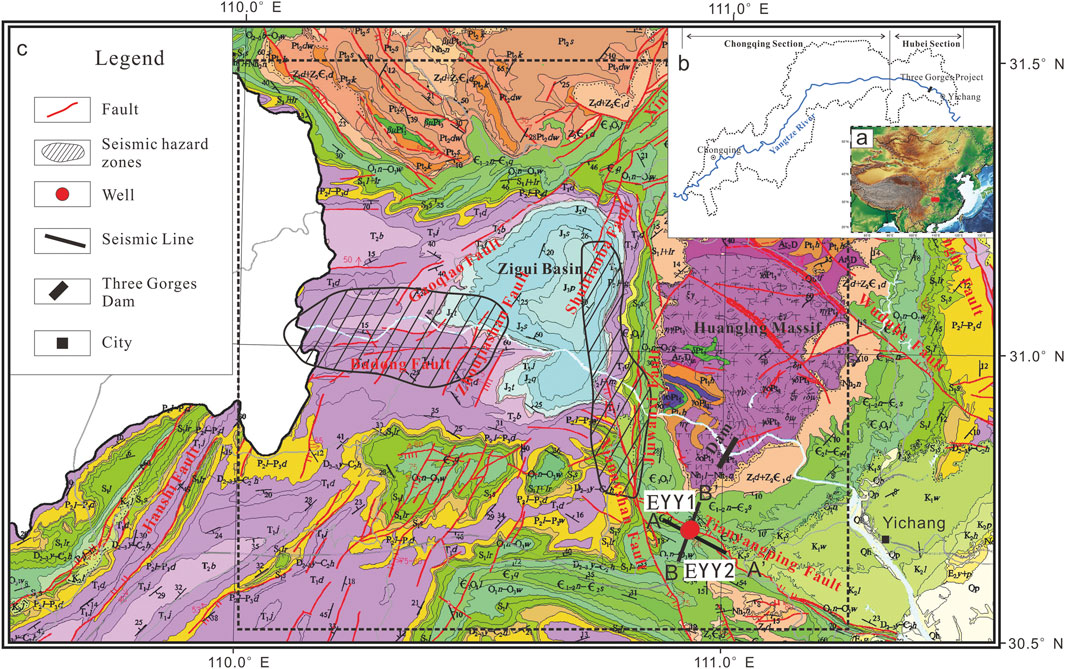
Figure 1. Geological map of the Western Hubei showing location and geological features in the Three Gorges Reservoir and surrounding area. (a) The location of the area in (c) is plotted as red solid rectangle; (b) The Three Gorges Reservoir Region is divided in Chongqing section and Hubei section; (c) Black dashed rectangle represents the reservoir head area of the Three Gorges Project located within the coordinates 30.5–31.5°N and 110–111.25°E.
This study provides a case study on RIS and HFIS in the Three Gorges Reservoir Region where reservoir water impoundment and shale gas extraction occur simultaneously within shared geological settings. Through systematic analysis of seismic data, the spatiotemporal evolution patterns of seismic activity are investigated and emerging cluster of earthquakes mainly occurring in the Xiannvshan Fault area are discussed. The relationship between the earthquake cluster and water impoundment activities or hydraulic fracturing operations is analyzed. Moreover, we also attempt to reveal whether the earthquakes are caused by fault activation.
2 Geological settings, impoundment history, and hydraulic fracturing process
2.1 Geological settings
The Three Gorges Reservoir Region is situated in the northern part of the stable Yangtze platform (Figure 1). The regional structural framework surrounding the Three Gorges Project site is dominated by the Huangling Massif (core of the Huangling Anticline), which serves as the central geological feature, surrounded by an extensive system of sedimentary cover folds and faults. To the north lies the NE to EW-trending Banmiao Fault; to the northwest, the NNE-trending Xinhua Fault and NE-trending Gaoqiao Fault; to the west, the NNE-trending Shuitianba Fault and Zhoujiashan (Niukou) Fault; to the southwest, the NNW-trending Xiannvshan Fault and NNE-trending Jiuwanxi Fault; to the south, the NWW-trending Tianyangping Fault; to the east, the NNW-trending Wuduhe Fault and Tongchenghe Fault. Despite the existence of numerous faults, the region has historically demonstrated low seismic activity due to its positioning on a stable crustal plate.
The stratigraphic exposure in western Hubei is comprehensive, featuring a sequential exposure of the Proterozoic, Paleozoic, and Mesozoic-Cenozoic strata. Since the Late Triassic period, terrestrial strata have been predominant (Figure 1). Within this region, four distinct suites of organic-rich shale have been identified: the Sinian Doushantuo Formation, the Cambrian Niutitang Formation, and the Ordovician to Lower Silurian Wufeng-Longmaxi formations, as well as the Permian Gufeng-Dalong formations.
Well EYY1 is situated on the southern wing of the Huangling Anticline, in proximity to the Tianyangping Fault zone. The distance between the wellheads of Well EYY1 and Well EYY2 is approximately 18 m to the east. Drilling operations conducted at Well EYY1 and Well EYY2 have unveiled the presence of two distinct black shale formations within the surveyed area, specifically the Sinian Doushantuo Formation and the Lower Cambrian Niutitang Formation.
2.2 Impoundment history
The impoundment process of the Three Gorges Reservoir was officially divided into three stages by the China Three Gorges Corporation (Figure 2). The first stage officially called the 135-m storage phase commenced on 25 May 2003 and completed on 24 September 2006, with the water level rising from 80 m to 135 m. The second stage was the 156-m water storage phase of the Three Gorges Reservoir from 25 September 2006 to 18 October 2008, with the water level rising from 135 m to 156 m. The third stage called the 175-m storage phase was from 19 October 2008 to 30 April 2014 with the water level rising from 156 m to 175 m. Then, based on the reservoir scheduling, the water level fluctuates annually between 145 m and 175 m as a certain regularity in the impoundment of the Three Gorges Reservoir.
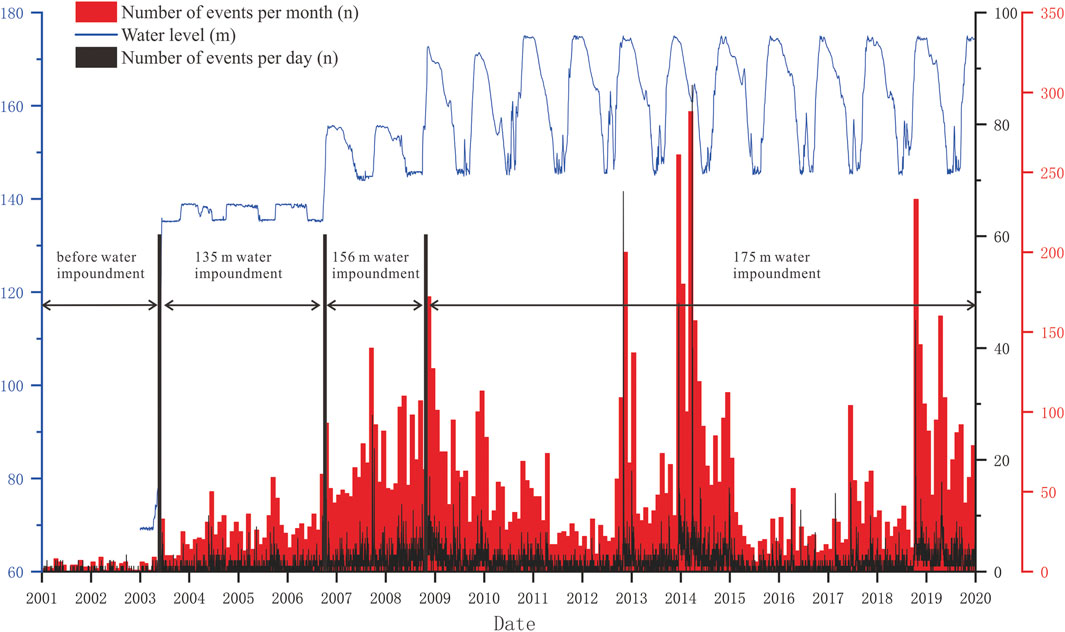
Figure 2. The synthetic graph of water level changes and daily, monthly frequency of the earthquakes in the Three Gorges Reservoir area. The water level stands for upstream water level and the impoundment data are from the China Three Gorges Corporation who manage the Three Gorges Project. The Three Gorges Reservoir area can be divided into two sections. See Figure 1b for more information.
2.3 Hydraulic fracturing process
Two main enabling technologies, namely, extended-reach horizontal drilling and multistage hydraulic fracture stimulation, contribute to the shale gas revolution (Alexander et al., 2011; Rutqvist et al., 2013). Hydraulic fracture stimulation in horizontal wells typically involves multiple stages using precisely controlled fluid volumes with specific chemical compositions. This study focuses on the fracturing operations of Well EYY1 and Well EYY2. Well EYY1 underwent comprehensive fracturing operations consisting of 33 stages, targeting the Cambrian Niutitang Formation shales at depths ranging from 2,700 m to 2,900 m. The operation was executed over a 32-day period from July 19 to 19 August 2017. Similarly, Well EYY2 was subjected to 23-stage hydraulic fracturing operations targeting the Sinian Doushantuo Formation shales at greater depths between 3,200 m and 3,400 m. Operations were completed within an 18-day period from May 29 to 15 June 2018. Notably, there were accompanied by the occurrence of clustered seismic events during the fracturing operations, suggesting a potential correlation between hydraulic fracturing activities and induced seismicity.
3 Data and methods
3.1 Data
The Three Gorges Digital Telemetering Seismic Network, which was completed at the end of 1999 and formally put into operation in 2001 and further upgraded in 2012, comprises 22 permanent telemetry stations built on the basement rocks and one seismic network center, ensuring the robustness of the earthquake monitoring. Those stations are equipped with high-sensitivity digital seismometers and interval distances between the seismic stations are about 10 km–15 km (Zhang et al., 2018) (Figure 3). The detection threshold of the network is down to magnitude −0.5, with the epicenter location accuracy of <1 km and the focal depth accuracy of <2 km (Yao et al., 2017). Since its deployment, the network has consistently recorded large number of earthquakes in the Three Gorges Reservoir Region, including the 135-m water impoundment stage from 25 May 2003, to 19 September 2006, the 156-m stage from 20 September 2006, to 27 September 2008; and the 175-m stage from 28 September 2008 till now.
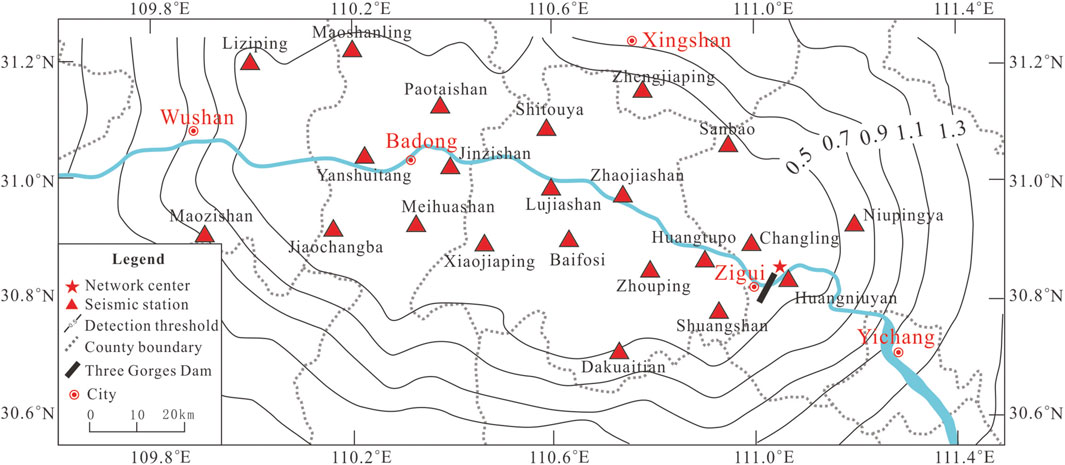
Figure 3. Monitoring capability of the Three Gorges Digital Telemetering Seismic Network (Modified after Yao et al., 2017).
In this study, the seismic data were collected from the seismic network, covering the seismic waveforms and high-precision earthquake catalog spanning the period from 1 January 2016 to 31 December 2019. The study focuses on the reservoir head area of the Three Gorges Project bounded by coordinates 30.5–31.5°N and 110–111.25°E (Figure 1). The dataset reveals a total of 4,142 seismic events within the study area, with annual distributions of 713 events in 2016, 1,235 events in 2017, 1,328 events in 2018, and 866 events in 2019 (Table 1). Seismic activity analysis indicates that majority of these events represent microseismicity, characterized by local magnitudes (ML) below 3.0. Notably, the catalog includes 17 events exceeding ML 3.0 and 5 significant events with magnitudes above ML 4.0.
3.2 Methods
With the aim to depict the morphology of the fault plane through seismicity, relative earthquake locations were performed by using the double-difference method implemented in the HypoDD code (Waldhauser and Ellsworth, 2000). This algorithm can not only effectively reduce the travel time calculation error caused by the imprecision of the crustal structure solution, but also locate large number of earthquakes with relatively large seismic event spacing at the same time. This algorithm uses the P-wave and S-wave differential travel time of the conventional absolute travel time measurement results, adjusts the loss difference between all observation event pairs by iteration, minimizes the residual between the observation differential travel time and the theoretical calculation differential travel time, updates the source parameters and partial derivative matrix after each iteration, and iteratively obtains the least squares solution of the double difference equations. The method pairs seismic events within a certain spatial range and obtains the relative spatial distribution of event pairs based on the phase arrival time differences between paired events. To ensure the reliability of seismic phase data, we screened the seismic phase observation report data from 1 January 2016 to 31 December 2019, and selected earthquake events that met the following two conditions: (1) Events must have been recorded by at least four seismic stations; (2) Events must have magnitudes exceeding 0. Utilizing these seismic phase data for earthquake relocation, we set a requirement that the number of seismic phases must be no less than six. There are seven pending parameters in HypoDD relocation process, among which MAXSEP and MINLNK are particularly critical. We set MAXSEP to 10 and MINLNK to 8. Out of the selected events, 2,283 earthquakes met this requirement. After earthquake event grouping, 1,319 earthquakes were ultimately incorporated into the relocation analysis. When the number of earthquakes is not large, SVD method can be used to get the precise location of earthquakes. But in practice, LSQR method is usually used to solve the problem because of the large number of earthquakes. Considering the large number of earthquakes in this study, we use LSQR method for iterative solution. In order to further eliminate the influence of velocity structure on locating, the relocation process employed a one-dimensional velocity model referenced in Table 2. After relocation analysis, RMS of earthquake location is 0.057 s. The conjugate gradient method LSQR computes estimates of the standard error for each model parameter. The error of most earthquake location is less than 200 m in horizontal direction and 250 m in vertical direction (Figures 4a–c). But LSQR results need to be reviewed by relocating subsets of events using SVD to get proper least squares error estimates. 91 events are choosing to get the error estimates using SVD method, which most earthquake location is less than 200 m in horizontal direction and 150 m in vertical direction (Figures 4d–f).
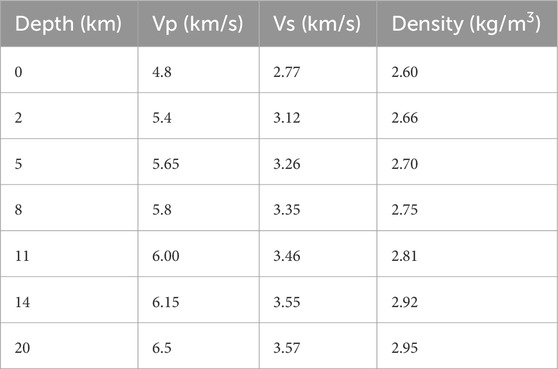
Table 2. 1D velocity model used in this study (Zhang et al., 2018).
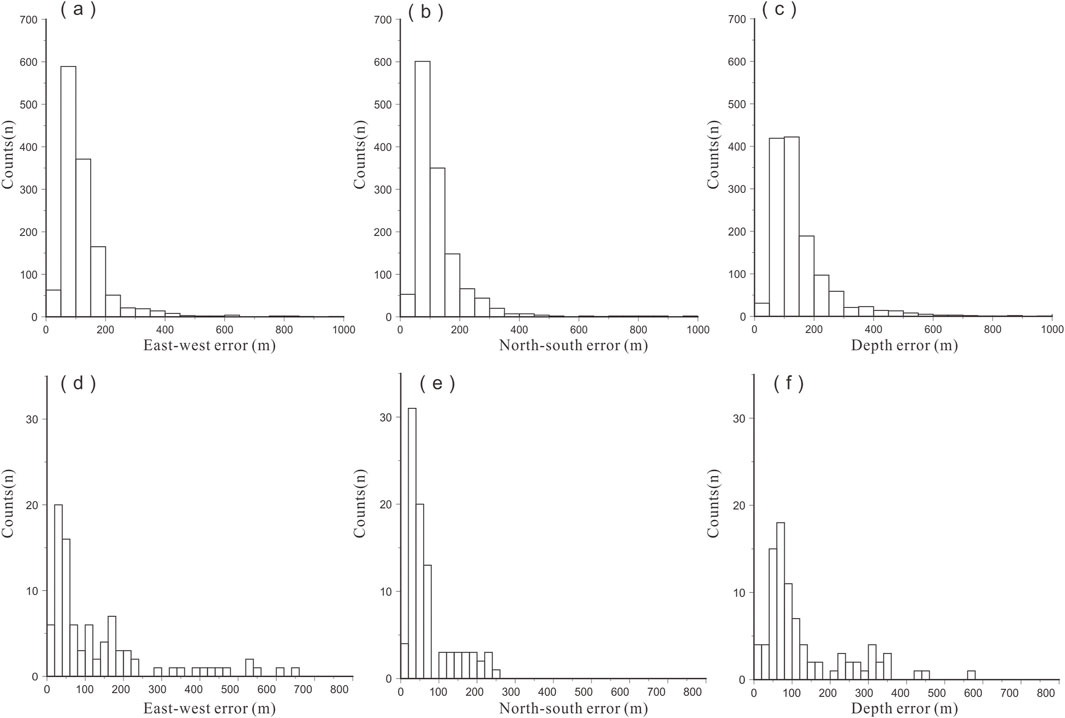
Figure 4. Histograms of relative earthquake location errors obtained using the LSQR and SVD method. (a,b) show relative errors in the horizontal directions using the LSQR method, while (c) shows relative errors in the vertical direction using the LSQR method. (d,e) show relative errors in the horizontal directions using the SVD method, while (f) show relative errors in the vertical direction using the SVD method.
4 Results and discussion
4.1 Temporal variation of the seismicity
The water level and earthquake numbers are depicted in Figure 5 with the water level fluctuating periodically between 145 m and 175 m. Generally, the Three Gorges Reservoir water-loading period commences in early September each year with water level of 145 m, and reaches a peak with water level of 175 m in October. The Badong M4.1 earthquake and M4.3 earthquake on 11 October 2018 occurred in the water-loading stages. Conversely, the water-unloading period begins in February, with the water level at 175 m, and continues until May when it drops back to 145 m. Zigui M4.0 earthquake on 23 February 2017 occurred in the water-unloading period, while Badong M4.1 and M4.3 earthquakes on June 16 and 18, 2017 happened in the low water level operation period.
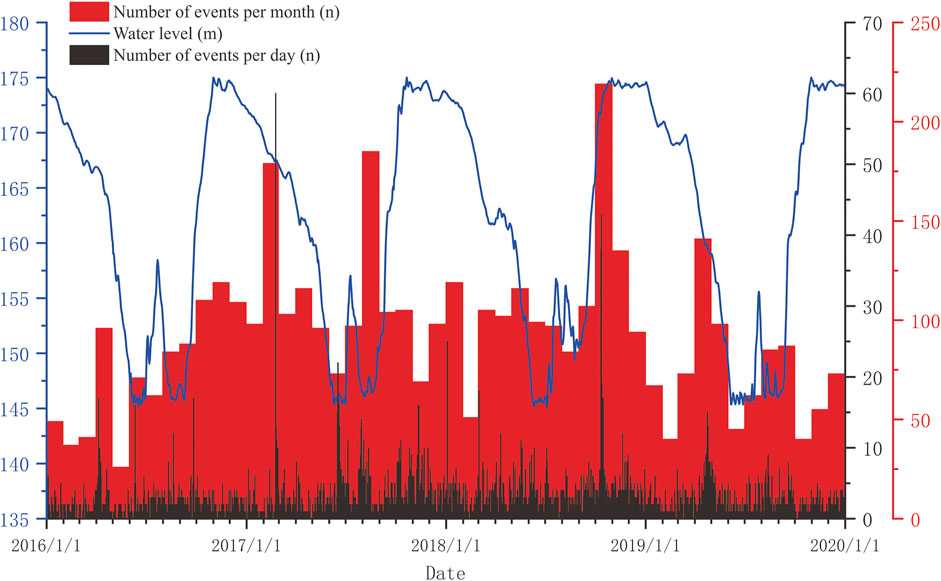
Figure 5. Water impoundment, number of earthquake events per month and day from 1 January 2016 to 31 December 2019.
Figure 5 presents a comparison of water impoundment history and temporal changes in statistical events. Fracturing operation on Well EYY1 with 33 hydraulic fracturing stages conducted from July 19 to 19 August 2017, and the number of events recorded are with 97 times in July and with 185 times in August much higher than that in 2016, 2018 and 2019. Hydraulic fracturing in Well EYY2 with 23 hydraulic fracturing stages were performed from May 29 to 15 June 2018 and the number of events recorded during this period is also higher than the average of other years.
4.2 Spatial variation of the seismicity
The spatial distribution of 4,142 selected earthquakes is illustrated in Figure 6a. As shown in Figure 6a, majority of the events were distributed along the Yangtze River and its branches. The earthquakes were primarily clustered in three sections: the section between northern of the Xiannvshan Fault zone and the Yanglinqiao town, the section between the southwestern of the Gaoqiao Fault zone and the Zhoujiashan Fault zone, and the section of the Sanxi River Fault zone and the karst development areas along the river. Five earthquakes with local magnitudes exceeding 4.0 were highlighted with yellow stars in Figures 6a,b. Among these, the largest one was the M4.3 (ML4.7) earthquake occurred on 11 October 2018.
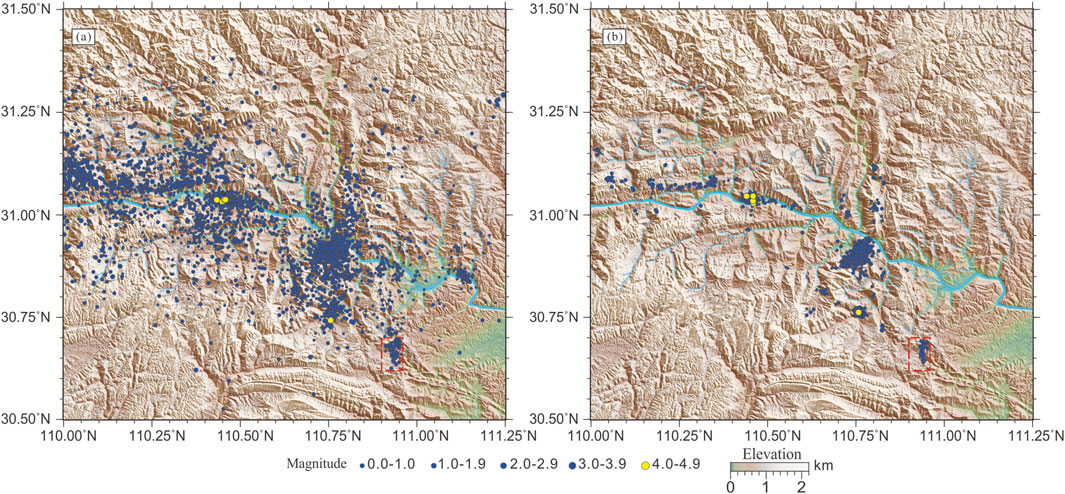
Figure 6. Spatial distribution of earthquakes from 1 January 2016 to 31 December 2019, in the reservoir head area of the Three Gorges Project. (a) Distribution of events epicenters before relocation; (b) Distribution of events epicenters after relocation. See Figure 1 for more information.
To have a further understanding of the spatial variation of the earthquake, distribution comparisons have been conducted for the period from 2016 to 2019 (Figure 7). Commonly, influenced by the annual periodic reservoir impoundment activities, seismic events in the reservoir area are mainly concentrated in the section between northern of the Xiannvshan Fault zone and the Yanglinqiao town, the section between the southwestern of the Gaoqiao Fault zone and the Zhoujiashan Fault zone, and the section of the Sanxi River Fault zone and the karst development areas along the river (Figures 7a–d). However, different from other periods, there was an anomaly in 2017, mainly primarily characterized by clusters of small earthquakes occurring around the Xiannvshan and Jiuwanxi faults (Figure 7b). Considering the locations of the earthquake clusters and the Well EYY1 and EYY2, only 59 seismic events within the range of 30.62–30.70°N and 110.90–110.96°E shown in Figure 6 (the range of red dashed rectangle) were selected for the following research. These seismic events may be related to hydraulic fracturing.
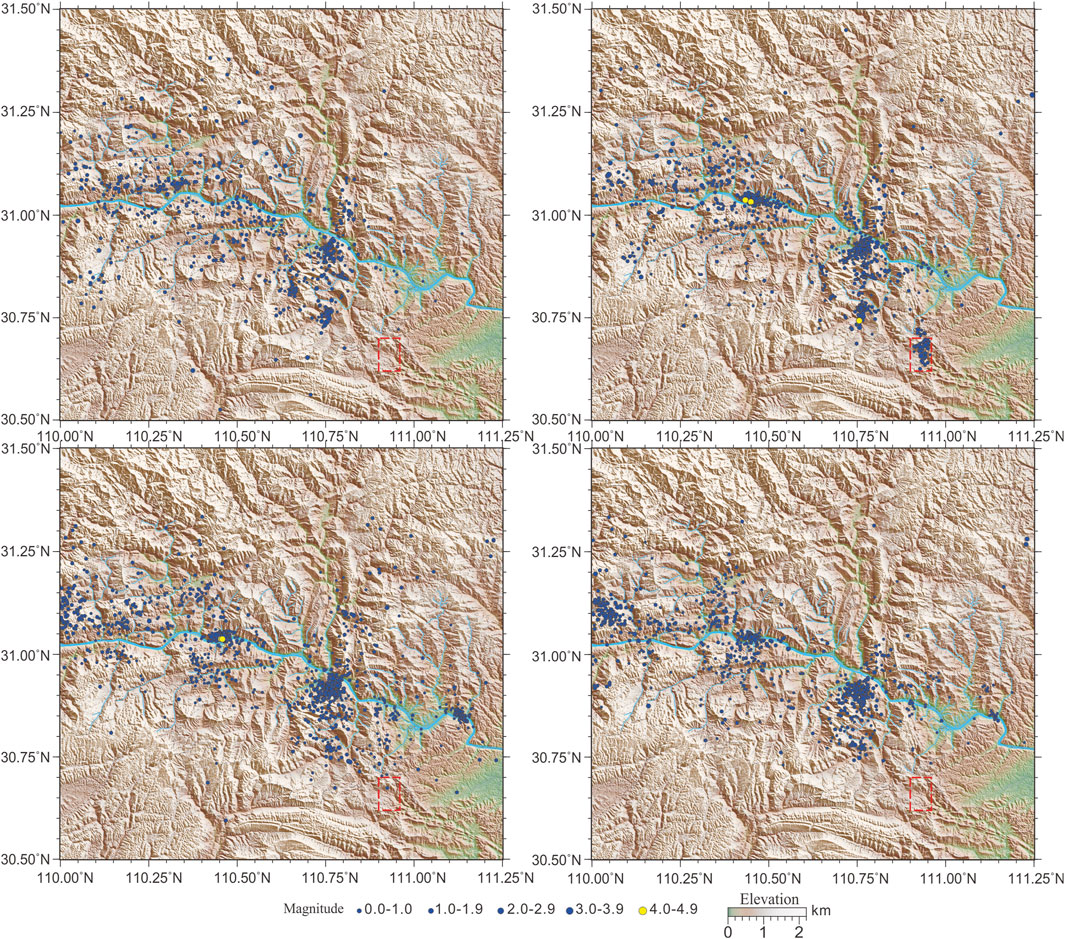
Figure 7. Variations of the earthquake epicenter locations over time from 1 January 2016 to 31 December 2019, in the reservoir head area of the Three Gorges Project. (a) Spatial distribution of earthquakes in 2016; (b) Spatial distribution of earthquakes in 2017; (c) Spatial distribution of earthquakes in 2018; (d) Spatial distribution of earthquakes in 2019. The red dashed rectangle delineates the epicentral region of emerging seismic activity, geographically bounded between latitudes 30.62°N to 30.70°N and longitudes 110.90°E to 110.96°E.
4.3 The relationship between the emerging seismicity and hydraulic fracturing or impoundment
Before the water impoundment, there were about 2000 years’ historical earthquake records and 45 years’ earthquake observation data in the Three Gorges Reservoir and adjacent region (Yao et al., 2017). Three medium strong earthquakes were recorded during the 45 years, including a 22 May 1979 M5.1 earthquake in Zigui, Hubei Province, a 20 November 1989 M4.7 and a 20 November 1989 M5.3 earthquake in Yubei, Chongqing. The 45 years’ earthquakes show a scattered distribution and observation data can be generally divided into two portions, namely, one from January 1959 to December 2000 and the other one from January 2001 to May 2003. Due to the limitation of the observation conditions and the instruments (analogue records), the monitoring ability is insufficient for the earthquakes smaller than M2.0, totally 99 earthquakes were recorded and the maximum annual frequency of the earthquakes was only 14 from 1959 to 2000 in the Three Gorges Reservoir. The number of the seismic events from January 2001 to May 2003 was 179 and the maximum annual frequency was around thirteen (Yao et al., 2017). The region where the Three Gorges dam is located is relatively stable and had experienced only a few earthquakes in the past.
It has been over 22 years since the first water impoundment on 25 May 2003. The whole process of water impoundment of the Three Gorges Project was divided into three stages: the 135-m water impoundment stage, the 156-m stage, and the 175-m stage. Water impoundment variation annually between 145 m and 175 m each year has affected the gravitational field, crustal deformation field, stress field and so forth in the reservoir and adjacent regions. The number of earthquakes remarkably increased in the reservoir. Most of earthquakes are micro and small earthquakes, and have focal depths exceeding 5 km while some of them even spread up to 15 km. The average monthly frequency of all magnitude scales in Hubei section is higher than the Chongqing section. Spatial distribution of the earthquakes is mainly in the Badong and Zigui region of the Hubei reservoir section and the ongoing earthquake distribution generally matches Figure 5, demonstrating that the level of seismicity in the Hubei section has been strongly affected by the reservoir. Yao et al. (2017) point out that b value of all the earthquakes from 2003 to 2016 in the Hubei section was around 0.97 which is larger than b value of the natural earthquakes with 0.6–0.8 in general. Increased vertical stress due to the load of the reservoir and decreased effective stress due to pore pressure can modify the stress regime in the reservoir region (Simpson, 1976). Yao et al. (2017) noted that most of the reservoir induced earthquakes belonged to the rapid response before 2010, while long-term water infiltration played a more important role in triggering the earthquakes after 2010. Majority of the earthquake focal mechanisms belong to reverse and strike slip fault type after 2012, while that before 2010 belong to normal fault and strike-slip fault type (Yao et al., 2017; Zhang et al., 2018; Zhang et al., 2019). Figure 2 predominantly exhibits a rapid-response relationship in the Three Gorges Reservoir area during the initial filling of the reservoir. Although 16 years have elapsed since the impoundment commencement in 2003 through 2019, comparative analysis by visual inspection of seismic activity before and after reservoir impoundment in Figure 2 still shows a correlation between the earthquakes and the water level fluctuations. Given the shared dataset, our conclusions regarding the b-value and focal mechanism solutions align consistently with prior analyses. In this study, we identify distinct spatial distributions of seismicity during the years from 2016 to 2019. To investigate the impact of reservoir impoundment and hydraulic fracturing on the emerging earthquakes, the earthquakes within the range of 30.5–31.5°N and 110–111.25°E were relocated (Figure 6B). The 1D velocity model and double-difference method (Waldhauser and Ellsworth, 2000) were employed in the relocation process, utilizing catalog phase data from the local seismic network. Out of the 59 events, only 31 events met the requirement and were incorporated into the relocation analysis. Figure 8A shows the hypocenters of the events after relocation within the range of 30.62–30.70°N and 110.90–110.96°E. The relocated earthquake sequence shows a clear linear distribution in the NW orientation, and spans total length of approximately 2 km. The earthquake epicenters are mainly concentrated in the depth of 3 km–9 km. The seismicity in the study area had a spatial correlation with the Well EYY1 and Well EYY2. Figures 8b,c show the microseismic monitoring results to evaluate the effectiveness of fracturing, indicating that the microseismic activities occurred primarily along the direction of the fractured layer section and the horizontal section of the wells and suggesting a strong spatial relationship between the emerging earthquakes and the hydraulic fracturing activities.
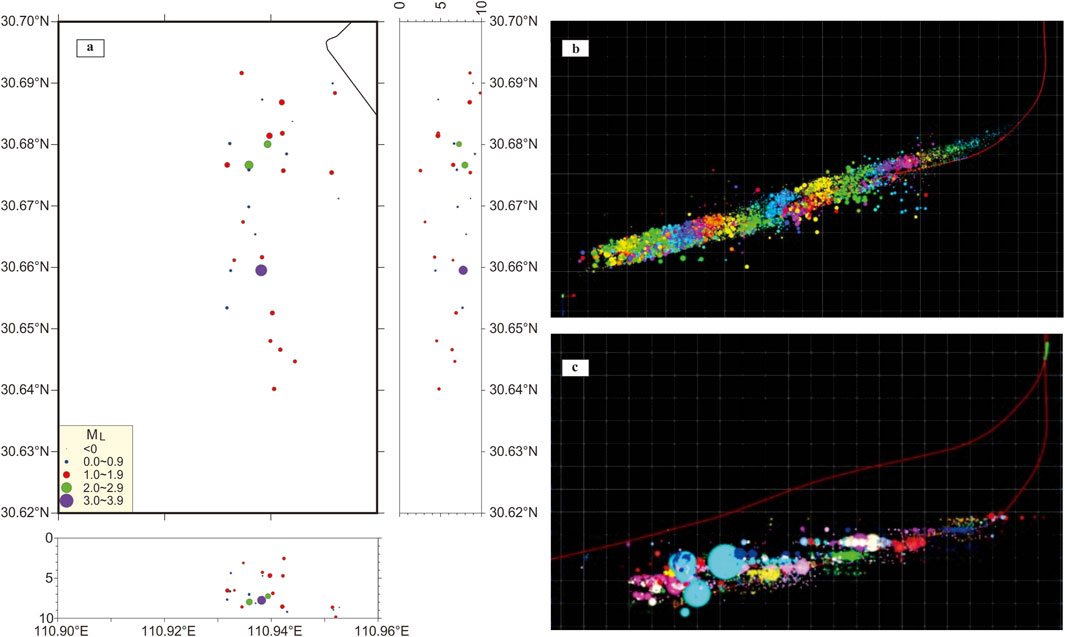
Figure 8. Distribution of emerging earthquake epicenters. (a) Distribution of events epicenters recorded by the Three Gorges Seismic Network after relocation; (b) Surface microseismic monitoring results of the 33-stage fracturing operations in the Well EYY1 with a NZ direction; (c) Surface microseismic monitoring results of the 23-stage fracturing operations in the Well EYY2 with a NZ direction.
It is interesting that emerging earthquakes mainly occurred during July to August 2017 and June 2018 with virtually no earthquakes detected in other months in this area (Figure 9). The impoundment of the Three Gorges Reservoir has persisted for decades, whereas no seismic activity was observed in this area before 2017. This pattern suggests that there is no clear correlation between emerging earthquakes and the water impoundment of the Three Gorges Reservoir. Well EYY1 underwent a comprehensive fracturing operations consisting of 33 stages from July 19 to 19 August 2017 and Well EYY2 was subjected to 23-stage hydraulic fracturing operations from May 29 to 15 June 2018. The occurrence of emerging earthquakes exhibits a temporal coincidence with the hydraulic fracturing operations. It is reasonable to conclude that the emerging earthquakes were induced by the hydraulic fracturing and that the relationship between seismicity observed and hydraulic fracturing activities belongs to the rapid-response type.
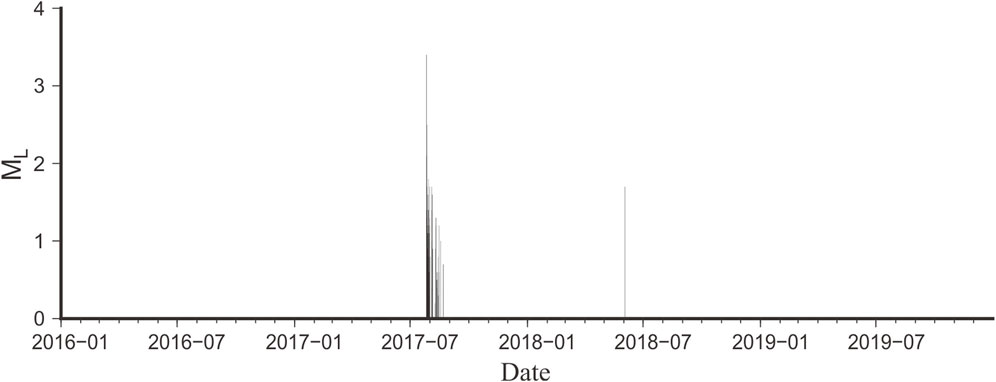
Figure 9. M-t diagram of the emerging earthquakes from 1 January 2016 to 31 December 2019. See Figure 7 for more information.
4.4 Were faults reactivated by hydraulic fracturing?
The energy released by hydraulic fracturing generally triggers microseismic events below magnitude 2, with most being below magnitude 1, and they are not destructive. During the hydraulic fracturing process, the fractures created can extend over hundreds of meters. If there are large natural faults within or near this range, the injection of fluid or the increase in formation pressure due to hydraulic fracturing can alter the original in-situ stress, which could very likely reactivate the faults and trigger earthquakes of larger magnitudes (Ellsworth, 2013; Zhang et al., 2021). Moreover, if hydraulic fractures intersect with natural faults and a large amount of fracturing fluid enter those faults, it may lead to significant loss of fracturing fluid and a substantial increase in the well’s water production (Ellsworth, 2013; Zhang et al., 2021). Bao and Eaton (2016) studied the fault reactivation caused by hydraulic fracturing in western Canada and identified a Mw 3.9 earthquake that occurred several weeks after water injection along the fault as the largest event in the region (Bao and Eaton, 2016). Schultz and Wang (2020) reported on the seismic swarms induced by hydraulic fracturing in the Duvernay East Shale Basin, which led to the reactivation of north-south oriented faults (Schultz and Wang, 2020).
The potential linkage between observed seismicity and fault reactivation requires careful evaluation given the proximity of the Jiuwanxi Fault, Tiangyangping Fault and Xiannvshan Fault to the study area (Figure 1). A critical analysis of the representative seismic profile (Figure 10a) reveals no discernible phase-axis discontinuities within the horizontal section, demonstrating the absence of major fault in the target formation along the wellbore trajectory. Figure 10b demonstrates that Tianyangping Fault is a reverse fault and crosscuts the sedimentary formations. Was the Tianyangping Fault reactivated by hydraulic fracturing operations? The relocated emerging earthquake sequence in Figure 8a shows a clear linear distribution in a NW orientation, differing from the NWW-striking Tianyangping Fault. The microseismic activities occurred primarily along the direction of the fractured layer section and the horizontal section of the wells (Figures 8b,c). What’s more, emerging earthquakes belonging to the rapid-response type were recorded during the hydraulic fracturing operations. The analysis rules out fault reactivation as a causative mechanism for the induced seismicity, attributing the observed seismic events to hydraulic fracturing-induced tensile/shear failure mechanisms within intact rock masses.
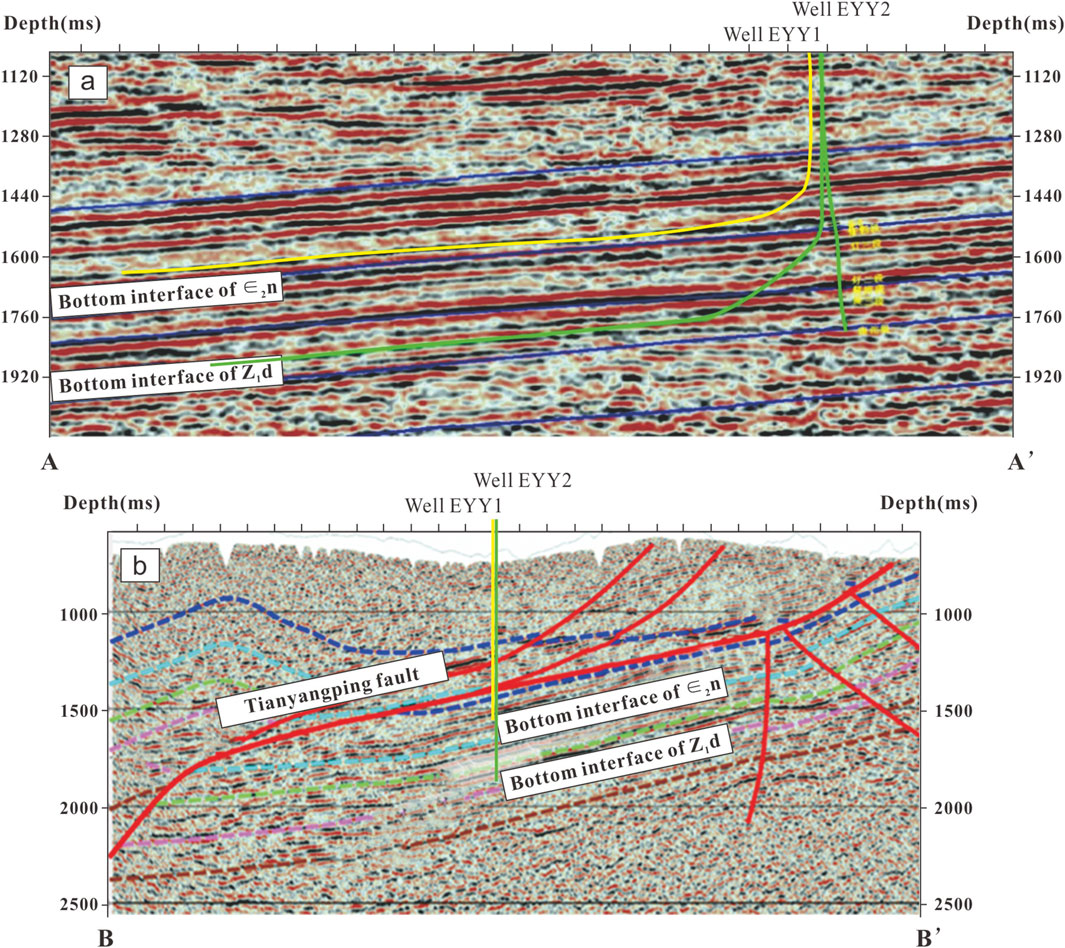
Figure 10. (A-A’, B-B’) seismic profiles of the southern margin of the Huangling Massif. The primitive seismic profiles are from Wuhan Center, China Geological Survey (Central South China Innovation Center for Geosciences). In this study, the yellow line represents the wellbore trajectory of EYY1, and the green line with a horizontal direction represents the wellbore trajectory of EYY2. ∈2n referred to the Cambrian Niutitang Formation and Z1d is the abbreviation for the Sinian Doushantuo Formation. See Figure 1 for more information.
Hydraulic fracturing operations induce significant perturbations to the local stress regime through high-pressure fluid injection. This process elevates pore fluid pressure within reservoir formations, modifying rock failure behavior through the coupled effects of the Mohr-Coulomb shear failure criterion and effective stress principles (Feng et al., 2021). The resultant fracture network architecture exhibits strong directional dependence on both pre-existing natural fractures and the contemporary in-situ stress field. According to the survey, the overall orientation of the main fracture network is in the NWW direction, which is highly consistent with the current maximum horizontal principal stress orientation in the Niutitang Formation and the Doushantuo Formation. It indicates that the distribution of the fracture network and the overall orientation of microseismic responses are primarily controlled by the current in-situ stress field. The observed disparity in seismic event counts between the Doushantuo and Niutitang shale formations during stimulation operations likely stems from variations in depth, as well as changes in the lithological combination and physical-mechanical properties of the formations themselves.
5 Conclusion
Identification on RIS and HFIS in the Xiannvshan Fault area of the Three Gorges Reservoir Region is investigated by comparing the spatial and temporal distribution characteristics of earthquakes from the year of 2016–2019. The main conclusions are as follows:
(1) Most of the micro and small earthquakes were induced by the impoundment of water reservoir in Three Gorges Reservoir, and were mainly distributed along the Yangtze River and its branches.
(2) The emerging clusters of earthquakes in the Xiannvshan Fault area were induced by hydraulic fracturing, rather than by impoundment of water reservoir, and the relationship between seismicity observed and hydraulic fracturing activities belongs to the rapid-response type.
(3) The seismic events observed in this region are predominantly associated with rock fracturing processes controlled by pre-existing natural fractures and in-situ stress regimes, with no evidence suggesting fault reactivation induced by hydraulic fracturing operations. The observed disparity in seismic event counts between the Doushantuo and Niutitang shale formations during hydraulic stimulation operations likely stems from variations in depth, as well as changes in the lithological combination and physical-mechanical properties of the formations themselves.
Data availability statement
Original data in the paper are not available due to confidentiality reasons and further inquiries can be directed to the corresponding author. The procedures of the methods have been presented at https://www.ldeo.columbia.edu/∼felixw/HYPODD/.
Author contributions
GT: Writing – original draft, Writing – review and editing. XZ: Writing – original draft, Writing – review and editing. WQ: Writing – original draft, Writing – review and editing. LZ: Writing – original draft, Writing – review and editing.
Funding
The author(s) declare that financial support was received for the research and/or publication of this article. This work was supported by Research on the Impact of Shale Gas Extraction Activities in Western Hubei on Surrounding Engineering Geological Conditions (No. 0799277), and Research on the Seismic Activity Characteristics and Seismic Damage Rapid Assessment in the Reservoir of the Baihetan Hydropower Station (No. JGGJ030224002).
Conflict of interest
Authors GT and WQ were employed by China Three Gorges Corporation.
Authors XZ and LZ were employed by Three Gorges Geotechnical Consultants Co., LTD.
Generative AI statement
The author(s) declare that no Generative AI was used in the creation of this manuscript.
Publisher’s note
All claims expressed in this article are solely those of the authors and do not necessarily represent those of their affiliated organizations, or those of the publisher, the editors and the reviewers. Any product that may be evaluated in this article, or claim that may be made by its manufacturer, is not guaranteed or endorsed by the publisher.
References
Alexander, T., Baihly, J., Boyer, C., Clark, B., Waters, G., Jochen, V., et al. (2011). Shale gas revolution. Oilfield Rev. Autumn 23, 40–55.
Bao, X. W., and Eaton, D. W. (2016). Fault activation by hydraulic fracturing in western Canada. Science 354, 1406–1409. doi:10.1126/science.aag2583
Carder, D. S. (1945). Seismic investigations in the Boulder Dam area, 1940-1944, and the influence of reservoir loading on local earthquake activity. Bull. Seismol. Soc. Am. 35, 175–192. doi:10.1785/bssa0350040175
Chen, Y., Yin, T., Li, X., Li, Q., Yang, Z., Li, M., et al. (2021). Experimental investigation on dynamic mechanical behavior and fracture evolution of fissure-filled red sandstone after thermal treatment. Eng. Geol. 295, 106433. doi:10.1016/j.enggeo.2021.106433
Dahm, T., KrüGer, F., Stammler, K., Klinge, K., Kind, R., Wylegalla, K., et al. (2007). The 2004 Mw 4.4 Rotenburg, Northern Germany, earthquake and its possible relationship with gas recovery. Bull. Seismol. Soc. Am. 97, 691–704. doi:10.1785/0120050149
Davies, R., Foulger, G., Bindley, A., and Styles, P. (2013). Induced seismicity and hydraulic fracturing for the recovery of hydrocarbons. Mar. Petroleum Geol. 45, 171–185. doi:10.1016/j.marpetgeo.2013.03.016
Ellsworth, W. L. (2013). Injection-induced earthquakes. Science 341, 1225942. doi:10.1126/science.1225942
Eyre, T. S., Eaton, D. W., Garagash, D. I., Zecevic, M., Lawton, D. C., Weir, R., et al. (2019). The role of aseismic slip in hydraulic fracturing-induced seismicity. Sci. Adv. 5, eaav7172. doi:10.1126/sciadv.aav7172
Feng, X. L., Ma, F. S., Zhao, H. J., and Guo, J. (2021). Numerical simulation of hydraulic fracturing in shale gas reservoirs under fault influence. J. Eng. Geol. 29, 751–763. doi:10.13544/j.cnki.jeg.2020-372
Gupta, H. K. (2002). A review of recent studies of triggered earthquakes by artificial water reservoirs with special emphasis on earthquakes in Koyna, India. Earth-Science Rev. 58, 279–310. doi:10.1016/S0012-8252(02)00063-6
Gupta, H. K., Rastogi, B. K., and Narain, H. (1972). Common features of the reservoir-associated seismic activities. Bull. Seismol. Soc. Am. 62, 481–492. doi:10.1785/bssa0620020481
Hu, J., Xu, B., Chen, Z., Zhang, H., Cao, J., and Wang, Q. (2021). Hazard and risk assessment for hydraulic fracturing induced seismicity based on the Entropy-Fuzzy-AHP method in Southern Sichuan Basin, China. J. Nat. Gas Sci. Eng. 90, 103908. doi:10.1016/j.jngse.2021.103908
Hui, G., Chen, S., Chen, Z., and Gu, F. (2021). An integrated approach to characterize hydraulic fracturing-induced seismicity in shale reservoirs. J. Petroleum Sci. Eng. 196, 107624. doi:10.1016/j.petrol.2020.107624
Hui, G., Chen, Z. X., Lei, Z. D., Song, Z. J., Zhang, L. Y., Yu, X. R., et al. (2023). A synthetical geoengineering approach to evaluate the largest hydraulic fracturing-induced earthquake in the East Shale Basin, Alberta. Petroleum Sci. 20, 460–473. doi:10.1016/j.petsci.2023.01.006
Jun, H., Jie, C., Zheng, C., Junxing, C., Quanfeng, W., Libo, Z., et al. (2018). Risk assessment of seismic hazards in hydraulic fracturing areas based on fuzzy comprehensive evaluation and AHP method (FAHP): a case analysis of Shangluo area in Yibin City, Sichuan Province, China. J. Petroleum Sci. Eng. 170, 797–812. doi:10.1016/j.petrol.2018.06.066
Lei, X., Huang, D., Su, J., Jiang, G., Wang, X., Wang, H., et al. (2017). Fault reactivation and earthquakes with magnitudes of up to Mw4.7 induced by shale-gas hydraulic fracturing in Sichuan Basin, China. Sci. Rep. 7, 7971. doi:10.1038/s41598-017-08557-y
Leith, W., Simpson, D. W., and Alvarez, W. (1981). Structure and permeability: geologic controls on induced seismicity at Nurek reservoir, Tadjikistan, USSR. Geology 9, 440. doi:10.1130/0091-7613(1981)9<440:sapgco>2.0.co;2
Li, T., Sun, J., Bao, Y., Zhan, Y., Shen, Z. K., Xu, X., et al. (2021). The 2019 Mw 5.8 Changning, China earthquake: a cascade rupture of fold-accommodation faults induced by fluid injection. Tectonophysics 801, 228721. doi:10.1016/j.tecto.2021.228721
Liu, G., Shang, D., Zhao, Y., Du, X., Wang, W., Zhu, H., et al. (2024). Characterization of brittleness index of gas shale and its influence on favorable block exploitation in southwest China. Front. Earth Sci. 12, 1389378. doi:10.3389/feart.2024.1389378
Luo, S. Y., Chen, X. H., Yue, Y., Li, P. J., Cai, Q. S., and Yang, R. Z. (2020). Analysis of sedimentary-tectonic evolution characteristics and shale gas enrichment in Yichang area, Middle Yangtze. Nat. Gas. Geosci. 31, 1052–1068. doi:10.11764/j.issn.1672-1926.2020.04.031
Ren, Q. Q., Li, L. F., Wang, J. W., Jiang, R. T., Li, M. P., and Feng, J. W. (2024). Dynamic evolution mechanism of the fracturing fracture system—enlightenments from hydraulic fracturing physical experiments and finite element numerical simulation. Petroleum Sci. 21, 3839–3866. doi:10.1016/j.petsci.2024.09.004
Rutqvist, J., Rinaldi, A. P., Cappa, F., and Moridis, G. J. (2013). Modeling of fault reactivation and induced seismicity during hydraulic fracturing of shale-gas reservoirs. J. Petroleum Sci. Eng. 107, 31–44. doi:10.1016/j.petrol.2013.04.023
Schultz, R., and Wang, R. (2020). Newly emerging cases of hydraulic fracturing induced seismicity in the Duvernay East Shale Basin. Tectonophysics 779, 228393. doi:10.1016/j.tecto.2020.228393
Schultz, R., Wang, R., Jeffrey, Y., Kristine, G., and Gail, H. (2017). A seismological overview of the induced earthquakes in the Duvernay play near Fox Creek, Alberta. J. Geophys. Res. Solid Earth 22, 492–505. doi:10.1002/2016JB013570
Simpson, D. W. (1976). Seismicity changes associated with reservoir loading. Eng. Geol. 10, 123–150. doi:10.1016/0013-7952(76)90016-8
Soboleva, O. V., and Mamadaliev, U. A. (1976). The influence of the Nurek Reservoir on local earthquake activity. Eng. Geol. 10, 293–305. doi:10.1016/0013-7952(76)90028-4
Stabile, T. A., Fat-Helbary, E. R., Serlenga, V., Panebianco, S., Tizzani, P., Castaldo, R., et al. (2024). Fault structure and earthquake clustering in Aswan region (Egypt) revealed by high-precision earthquake location from 35 years of recorded natural and induced seismicity. Earth Planet. Sci. Lett. 642, 118881. doi:10.1016/j.epsl.2024.118881
Suckale, J. (2010). Moderate-to-large seismicity induced by hydrocarbon production. Geophysics 29, 310–319. doi:10.1190/1.3353728
Sun, X., Yang, P., and Zhang, Z. (2017). A study of earthquakes induced by water injection in the Changning salt mine area, SW China. J. Asian Earth Sci. 136, 102–109. doi:10.1016/j.jseaes.2017.01.030
Waldhauser, F., and Ellsworth, W. L. (2000). A double-difference earthquake location algorithm: method and application to the Northern Hayward Fault California. Bull. Seismol. Soc. Am. 90, 1353–1368. doi:10.1785/0120000006
Wang, B., Harrington, R. M., Liu, Y., Kao, H., and Yu, H. (2020). A study on the largest hydraulic-fracturing-induced earthquake in Canada: observations and static stress-drop estimation. Bull. Seismol. Soc. Am. 110, 2283–2294. doi:10.1785/0120190261
Wang, R., Gu, Y. J., Schultz, R., Kim, A., and Atkinson, G. (2016). Source analysis of a potential hydraulic-fracturing-induced earthquake near Fox Creek, Alberta. Geophys. Res. Lett. 43, 564–573. doi:10.1002/2015GL066917
Wang, S., Gu, Z., Guo, P., and Zhao, W. (2024). Comparative laboratory wettability study of sandstone, tuff, and shale using 12-MHz NMR T1-T2 fluid typing: insight of shale. SPE J. 29, 4781–4803. doi:10.2118/221496-PA
Xu, B., Hu, J., Hu, T., Wang, F., Luo, K., Wang, Q., et al. (2021). Quantitative assessment of seismic risk in hydraulic fracturing areas based on rough set and Bayesian network: a case analysis of Changning shale gas development block in Yibin City, Sichuan Province, China. J. Petroleum Sci. Eng. 200, 108226. doi:10.1016/j.petrol.2020.108226
Yao, Y. S., Wang, Q. L., Liao, W. L., Zhang, L. F., Chen, J. H., Li, J. G., et al. (2017). Influences of the Three Gorges Project on seismic activities in the reservoir area. Sci. Bull. 62, 1089–1098. doi:10.1016/j.scib.2017.07.014
Zhang, J., Kuang, W. H., Zhang, X., Mo, C. K., and Zhang, D. X. (2021). Global review of induced earthquakes in oil and gas production fields. Rev. Geophys. Planet. Phys. 52, 239–265. doi:10.16738/j.dqyxx.2020-027
Zhang, L., Lei, X., Liao, W., Li, J., and Yao, Y. (2019). Statistical parameters of seismicity induced by the impoundment of the Three Gorges Reservoir, Central China. Tectonophysics 751, 13–22. doi:10.1016/j.tecto.2018.12.022
Zhang, L., Li, J., Sun, X., Liao, W., Zhao, Y., Wei, G., et al. (2018). A possible mechanism of reservoir-induced earthquakes in the Three Gorges Reservoir, central China. Bull. Seismol. Soc. Am. 108, 3016–3028. doi:10.1785/0120180015
Zhang, P., Sun, X., Zong, J., Xiao, Z., and Shen, Y. (2024). Microseismicity detection and spatial-temporal migration in the Xinfengjiang reservoir, Guangdong, China. Phys. Earth Planet. Interiors 355, 107245. doi:10.1016/j.pepi.2024.107245
Zhao, C., Li, J., Jin, Y., Zaman, M., and Miao, Y. (2021). Investigation of dynamic pore pressure in shale gas reservoir during the multi-fracturing and its influence on fault slip. J. Nat. Gas Sci. Eng. 95, 104190. doi:10.1016/j.jngse.2021.104190
Zhao, C., Li, J., Liu, G., and Zhang, X. (2020). Analysis of well stress with the effect of natural fracture nearby wellbore during hydraulic fracturing in shale gas wells. J. Petroleum Sci. Eng. 188, 106885. doi:10.1016/j.petrol.2019.106885
Zhao, H., Liang, B., Sun, W., Hu, Z., Ma, Y., and Liu, Q. (2022). Effects of hydrostatic pressure on hydraulic fracturing properties of shale using X-ray computed tomography and acoustic emission. J. Petroleum Sci. Eng. 215, 110725. doi:10.1016/j.petrol.2022.110725
Zoback, M. D., and Townend, J. (2001). Implications of hydrostatic pore pressures and high crustal strength for the deformation of intraplate lithosphere. Tectonophysics 336, 19–30. doi:10.1016/S0040-1951(01)00091-9
Keywords: induced seismicity, impoundment, hydraulic fracturing, faults reactivation, Three Gorges Reservoir
Citation: Tong G, Zhu X, Qin W and Zhou L (2025) Induced seismicity by impoundment or hydraulic fracturing operation? A case study in the Xiannvshan Fault area of the Three Gorges Reservoir region. Front. Earth Sci. 13:1583819. doi: 10.3389/feart.2025.1583819
Received: 26 February 2025; Accepted: 11 June 2025;
Published: 26 June 2025.
Edited by:
Mourad Bezzeghoud, Universidade de Évora, PortugalReviewed by:
Muhsan Ehsan, Bahria University, PakistanTony Alfredo Stabile, Istituto di Metodologie per l'Analisi Ambientale, Italy
Copyright © 2025 Tong, Zhu, Qin and Zhou. This is an open-access article distributed under the terms of the Creative Commons Attribution License (CC BY). The use, distribution or reproduction in other forums is permitted, provided the original author(s) and the copyright owner(s) are credited and that the original publication in this journal is cited, in accordance with accepted academic practice. No use, distribution or reproduction is permitted which does not comply with these terms.
*Correspondence: Lu Zhou, cGllcm8uemhvdUBvdXRsb29rLmNvbQ==
 Guangqin Tong
Guangqin Tong Xiangfeng Zhu
Xiangfeng Zhu Weibing Qin
Weibing Qin Lu Zhou
Lu Zhou